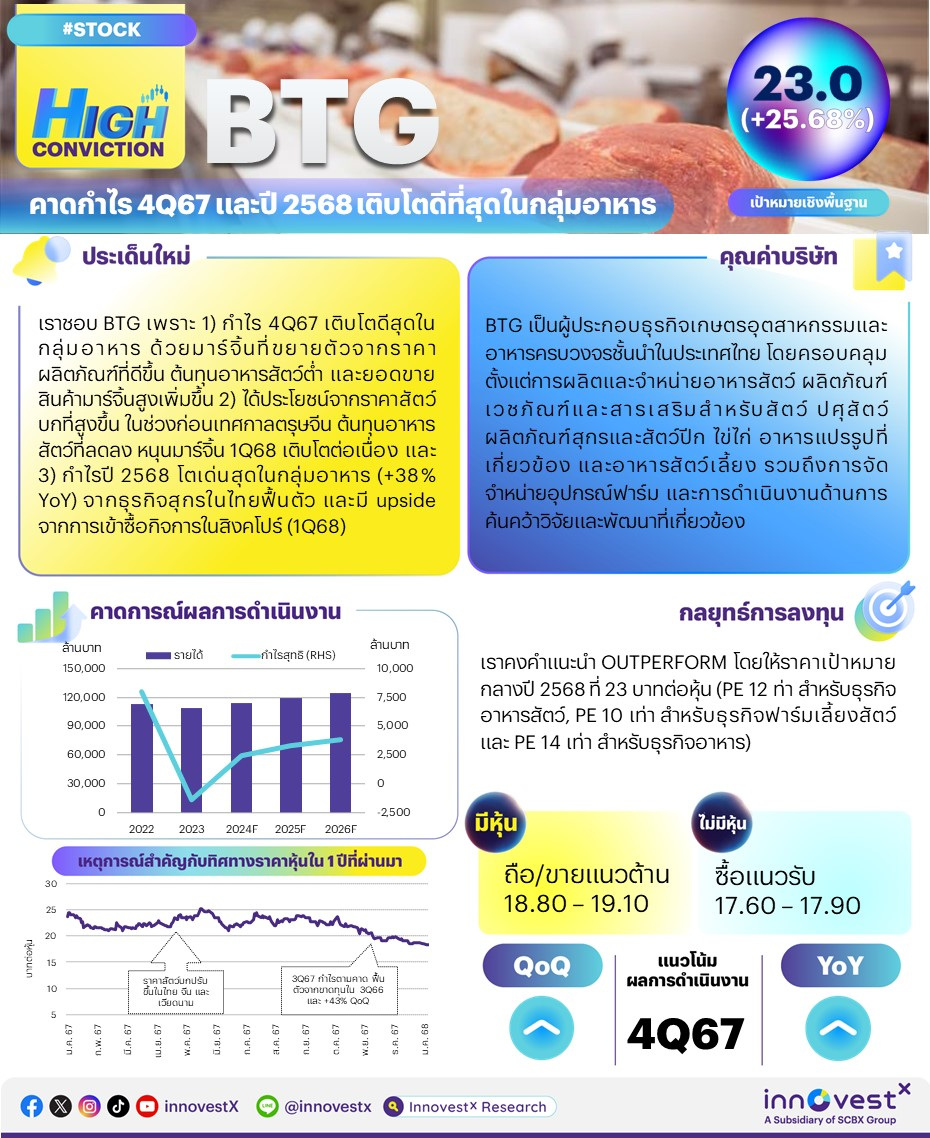High Conviction - BTG คาดกำไร 4Q67 และปี 2568 เติบโตดีที่สุดในกลุ่มอาหาร
เราชอบ BTG ด้วยเหตุผลดังต่อไปนี้ ประการแรก กำไรปกติ 4Q67 ของ BTG มีแนวโน้มที่จะมีโมเมนตัมการเติบโตดีที่สุดในกลุ่มอาหาร (เพิ่มขึ้น YoY และ QoQ) โดยได้แรงหนุนจากมาร์จิ้นที่ขยายตัวเพิ่มขึ้นเพราะราคาผลิตภัณฑ์ดีขึ้นและต้นทุนอาหารสัตว์ต่ำ และยอดขายผลิตภัณฑ์มาร์จิ้นสูงที่เพิ่มขึ้น ประการที่สอง BTG จะได้รับประโยชน์จากราคาสัตว์บกในประเทศที่สูงขึ้น (เพิ่มขึ้น MoM และ YoY) ในเดือนม.ค. ถึงปัจจุบันก่อนถึงเทศกาลตรุษจีน ปัจจัยนี้รวมกับต้นทุนอาหารสัตว์ที่ลดลง จะช่วยสนับสนุนให้มาร์จิ้นใน 1Q68 ขยายตัวอย่างต่อเนื่อง ประการที่สาม BTG จะรายงานกำไรปี 2568 เติบโตดีที่สุด (+38% YoY) ในกลุ่มอาหาร โดยหลักๆ จะได้แรงหนุนจากการฟื้นตัวของธุรกิจสุกรในประเทศไทย (จากฐานต่ำใน 1H67) และเรายังไม่ได้รวม upside ของกำไรจากการเข้าซื้อกิจการผู้ประกอบธุรกิจไข่ในสิงคโปร์เสร็จสิ้นใน 1Q68 เข้ามา

เรายังคงคำแนะนำ OUTPERFORM สำหรับ BTG โดยให้ราคาเป้าหมายกลางปี 2568 ที่ 23 บาท อ้างอิงวิธี sum-of-the-parts (PE 12 เท่า สำหรับธุรกิจอาหารสัตว์, PE 10 เท่า สำหรับธุรกิจฟาร์มเลี้ยงสัตว์ และ PE 14 เท่า สำหรับธุรกิจอาหาร)
ปัจจัยกระตุ้น #1: กำไรปกติ 4Q67 จะมีโมเมนตัมการเติบโตดีที่สุดในกลุ่มอาหาร เราคาดว่า BTG จะเป็นเพียงบริษัทเดียวในบรรดาบริษัทในกลุ่มอาหารภายใต้การวิเคราะห์ของเราที่จะรายงานผลประกอบการดีที่สุดของปี 2567 ใน 4Q67 โดยกำไรปกติจะปรับตัวดีขึ้น YoY และ QoQ ด้วยแรงหนุนจาก: 1) มาร์จิ้นที่กว้างขึ้นจากต้นทุนอาหารสัตว์ที่ลดลงและราคาผลิตภัณฑ์สัตว์บกที่ดีขึ้น (ราคาสุกรในประเทศอยู่ที่ 72 บาท/กก. (+10% YoY, +1% QoQ) ขณะที่ราคาไก่เนื้อในประเทศอยู่ที่ 38 บาท/กก. (+1% YoY, -11% QoQ)); 2) ยอดขายผลิตภัณฑ์มาร์จิ้น สูงที่เพิ่มขึ้นจากการขยายกำลังการผลิตและการปรับช่องทางการจัดจำหน่ายในธุรกิจอาหารสัตว์ (เพิ่มยอดขายอาหารสุกรผ่านการขยายกำลังการผลิต) และธุรกิจฟาร์มเลี้ยงสัตว์และธุรกิจอาหาร (เพิ่มการส่งออกไก่เนื้อและยอดขายบริการอาหารไก่เนื้อและสุกรสำหรับธุรกิจในประเทศไทย และยอดขายเนื้อสุกรและเนื้อไก่ที่เพิ่มขึ้น แทนที่ยอดขายสัตว์บกสำหรับธุรกิจต่างประเทศ)
ปัจจัยกระตุ้น #2: ราคาสัตว์บกในประเทศปรับตัวดีขึ้นในเดือนม.ค. ถึงปัจจุบัน ท่ามกลางต้นทุนอาหารสัตว์ที่ลดลง ในสัปดาห์นี้ ราคาสุกรและไก่เนื้อในประเทศปรับเพิ่มขึ้น 3% WoW มาอยู่ที่ 74 บาท/กก. และ 2% WoW มาอยู่ที่ 41.5 บาท/กก. ในขณะที่ราคาโครงไก่ในประเทศอยู่ในระดับทรงตัว WoW ที่ 21 บาท/กก. ในเดือนม.ค. ถึงปัจจุบัน ราคาสุกรและไก่เนื้อในประเทศปรับตัวเพิ่มขึ้นสู่ 74 บาท/กก. (+1% MoM, +7% YoY) และ 41 บาท/กก. (+4% MoM, +5% YoY) ในขณะที่ราคาโครงไก่ในประเทศปรับตัวเพิ่มขึ้นแรงสู่ 21 บาท/กก. (+22% MoM, +13% YoY) โดยปกติแล้ว ราคาสัตว์บกในประเทศจะปรับตัวสูงขึ้นจากความต้องการที่เพิ่มขึ้นในช่วงหลายสัปดาห์ก่อน และ/หรือในช่วงเทศกาลตรุษจีน ในปีนี้ เมื่อรวมกับมาตรการแจกเงินเฟสที่สองที่ครม.มีมติเห็นชอบ ในวงเงิน 4 หมื่นลบ. เพื่อแจกให้กับผู้สูงอายุจำนวน 4 ล้านคน ก่อนเทศกาลตรุษจีนในวันที่ 29 ม.ค. จะช่วยหนุนให้ราคาสัตว์บกในประเทศปรับตัวเพิ่มขึ้น ในด้านต้นทุน BTG เก็บสต๊อกอาหารสัตว์ไว้ 3-4 เดือน ดังนั้นบริษัทจะรับรู้ต้นทุนอาหารสัตว์จริงใน 1Q68 ลดลงตามราคา spot ข้าวโพดและกากถั่วเหลืองนำเข้าใน 4Q67 ที่ลดลงสู่ระดับต่ำสุดในรอบ 3 ปีที่ 10 บาท/กก. (-4% YoY, -17% QoQ) และ 19 บาท/กก. (-16% YoY, -8% QoQ) ราคาผลิตภัณฑ์ที่ปรับตัวสูงขึ้นท่ามกลางต้นทุนอาหารสัตว์ระดับต่ำ (หากยังดำเนินต่อไป) จะช่วยหนุนให้มาร์จิ้นใน 1Q68 ปรับตัวขึ้นได้อย่างต่อเนื่อง
ปัจจัยกระตุ้น #3: กำไรปี 2568 จะเติบโตดีที่สุดในกลุ่มอาหาร BTG มีแนวโน้มที่จะรายงานกำไรปี 2568 เติบโตดีที่สุด (+38% YoY) ในกลุ่มอาหาร โดยได้แรงหนุนจากอุตสาหกรรมสุกรในประเทศไทยที่ฟื้นตัวดีขึ้นจากฐานต่ำใน 1H67 จากอุปทานที่ดีขึ้นเพราะมีเนื้อสุกรที่ลักลอบนำเข้าลดลงและการลดอุปทานตามนโยบายของรัฐบาล อุตสาหกรรมไก่เนื้อที่ปรับตัวดีขึ้นปานกลางจากอุปสงค์และอุปทานในประเทศและการส่งออกที่สมดุล และต้นทุนอาหารสัตว์ที่ต่ำต่อเนื่องจากสภาวะการเพาะปลูกที่ดี เรายังไม่ได้รวม upside ของกำไร (+5-6% YoY) จากเข้าซื้อกิจการผู้ประกอบธุรกิจไข่ในสิงคโปร์ (Eggriculture) เสร็จสิ้นภายใน 1Q68 เข้ามาในประมาณการ ประมาณการกำไรปี 2567-2568 ของเราสูงกว่า consensus อยู่ 9% และ 19% และเรายังคงประมาณการของเราไว้เหมือนเดิม โดยมีมุมมองเชิงบวกต่อมาร์จิ้นที่ปรับตัวดีขึ้น
ความเสี่ยงที่สำคัญ คือ อุปสงค์และราคาที่ลดลงจากเศรษฐกิจที่เปราะบางและอุปทานที่มากขึ้น และต้นทุนอาหารสัตว์ที่สูงขึ้น ความเสี่ยงด้าน ESG ที่สำคัญ คือ การปล่อยก๊าซเรือนกระจก การบริหารจัดการขยะและน้ำ (E) สวัสดิภาพของลูกค้า การบริหารจัดการคุณภาพผลิตภัณฑ์ นโยบายด้านสุขภาพและความปลอดภัย (S)
The sector’s best growth in 4Q24F & 2025F
We like BTG for several reasons. First, its 4Q24F core earnings are expected to show the sector’s best growth momentum, up YoY and QoQ, from margin expansion on better product prices and low feed costs, plus more high-margin sales. Second, it will benefit from a rise in local livestock prices (up MoM & YoY) in Jan to date ahead of Chinese New Year. This, together with lower feed costs, will widen its 1Q25F margin further. Third, it is poised to post the sector’s best growth in 2025F (+38% YoY) mainly on a revived swine unit in Thailand (off the low 1H24 base), plus upside from the acquisition of an egg operator in Singapore in 1Q25, not yet included in our forecast. We stay Outperform with a mid-2025 SOTP TP of Bt23 (12x PE for feed, 10x PE farm and 14x PE food units).
Catalyst #1: 4Q24F core earnings growth momentum to lead the sector. Among food players under coverage, BTG is expected to be the leader in 4Q24F, with core earnings growing YoY and QoQ. Underwriting this is: 1) a wider margin from lower feed costs and better livestock product prices - local swine price was Bt72/kg (+10% YoY, +1% QoQ), while local broiler price was Bt38/kg (+1% YoY, -11% QoQ); 2) more high-margin sales brought by capacity expansion and distribution channel adjustment, including feed (increasing swine feed sales via capacity expansion) and farm & food units (raising broiler exports and broiler & swine food service sales at Thai operations and more pork & chicken meat sales, replacing livestock sales for international operations).
Catalyst #2: Local livestock prices up in Jan to date amid lower feed costs. This week, local swine price edged up 3% WoW to Bt74/kg and broiler price rose 2% WoW to Bt41.5/kg; local chicken rib price was flat WoW at Bt21/kg. In January to date, local swine and broiler prices have risen to Bt74/kg (+1% MoM, +7% YoY) and Bt41/kg (+4% MoM, +5% YoY), while local chicken rib price jumped to Bt21/kg (+22% MoM, +13% YoY). Normally, local livestock prices rise on better demand several weeks ahead of and during Chinese New Year. This year, the second cash handout approved by Cabinet of up to Bt40bn for four million elderly people ahead of Chinese New Year on January 29 will help support local livestock prices further. On the cost side, BTG keeps a 3-4-month feed inventory; thus, it will realize lower actual feed costs in 1Q25F in tandem with a drop in 4Q24 spot corn and imported soybean meal prices to a 3-year low at Bt10/kg (-4% YoY, -17% QoQ) and Bt19/kg (-16% YoY, -8% QoQ). Rising product prices amid low feed costs will, if they continue, widen margin further in 1Q25F.
Catalyst #3: Sector’s best growth in 2025F. BTG is poised to have the sector’s best earnings growth (+38% YoY) in 2025F from a revived local swine industry off the 1H24 low base from better supply with less smuggled pork and a supply reduction arranged by government policies, moderate improvement in the local broiler industry from balanced local and export demand and supply, and continued low feed costs brought by good crop conditions. We have not yet included earnings upside (+5-6%) from the completion of the purchase of the egg operator in Singapore (Eggriculture) within 1Q25. Our 2024F is 9% above consensus and our 2025F is 19% above; we leave forecasts unchanged in view of our anticipation of a better margin.
Key risks are lower demand and prices from fragile economies and more supply, and higher feed costs. Key ESG risks are GHG emission, waste & water management (E), customer welfare, product quality management, health & safety policies (S).
Download EN version click >> BTG_HighConviction250109_E.pdf